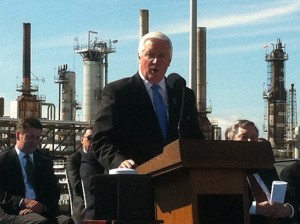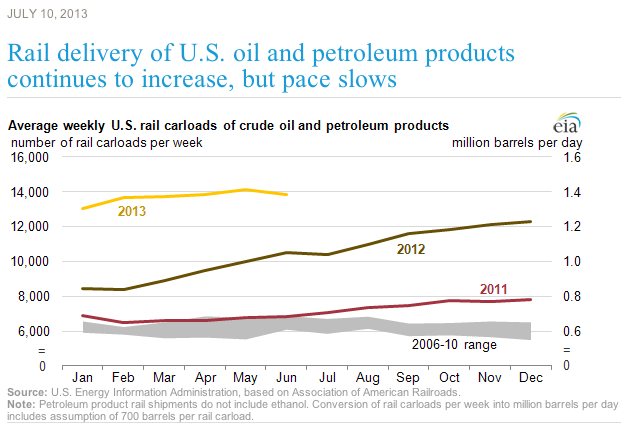Quebec Rail Accident Carried Same Crude that Travels to Philly Refineries
-
Susan Phillips

Susan Phillips / StateImpact Pennsylvania
Gov. Tom Corbett speaks at a press conference announcing the deal to keep the Sunoco plant open by shipping in shale oil from North Dakota via rail.
The press conference back in September 2012 had all the festivities of a street party. Republican and Democrats stood side-by-side on the stage smiling. Energy executives sweated in their dark suits. And refinery workers in blue jumpsuits cheered.
The 140-year-old Sunoco refinery had been saved thanks to the shale oil boom in North Dakota, which would now supply the site with crude oil shipped via rail. The railroad revival made everyone happy. Politicians from the White House to Philadelphia City Council helped make the deal happen. A private equity firm, the Carlyle Group, established a joint venture with Energy Transfer Partners and bought the refinery. And everyone was happy to talk.
Today, it’s hard to get anyone on the phone from either the new company, Philadelphia Energy Solutions, or the railroads. Last weekend, a rail shipment of crude oil that also originated in North Dakota’s Bakken Shale ran off the tracks in the tiny town of Lac Megantic, Quebec and exploded, killing at least 15 people, with about 40 people still missing. The train, operated by the Maine & Atlantic Railway, had been parked for the night but with no one on board, it rolled downhill toward the town, derailed and exploded, leveling parts of the town and leaving about 2,000 people homeless.
While Philadelphia’s refineries used to rely on crude oil from the Gulf Coast shipped up the coast on large tankers, today, trains carrying Bakken Shale crude oil now travel from North Dakota to Philadelphia. The rail shipments are part of a larger nationwide boom in rail traffic resulting from the oil and gas boom.

In fact, as North Dakota’s Bakken Shale oil production soars ahead of the nation’s pipeline capacity, rail shipments of crude oil and petroleum products have jumped almost 50 percent compared to last year, according to the Energy Information Administration.
“U.S. weekly carloadings of crude oil and petroleum products averaged nearly 13,700 rail tankers during the January-June 2013 period. With one rail carload holding about 700 barrels, the amount of crude oil and petroleum products shipped by rail was equal to 1.37 million barrels per day during the first half of 2013, up from 927,000 barrels per day during the first six months of last year. Crude oil accounts for about half of those 2013 daily volumes, according to AAR.”—EIA’s Today in Energy
Philadelphia Energy Solutions did not return StateImpact’s calls for comment on the rail shipments but in a Reuter’s article published last February, PES CEO Phil Rinaldi is quoted as telling attendees of the New York Energy Forum that the refiner planned to use rail lines to ship 140,000 barrels of crude oil from North Dakota by the third quarter of this year.
“By April 1, PES will be able to accept two or three unit trains filled with crude per week. By July and perhaps as early as the end of May, it will take five unit trains, and in the third quarter of this year, 14 in total, Rinaldi said.”
Reuters reported that PES planned to ship 70,000 barrels of crude daily in 120 car trains that stretched 1.5 miles, to its Point Breeze and Girard Point plants.
It’s unclear which rail lines actually carry the crude. Norfolk Southern would not comment on the rail accident in Quebec, and told StateImpact that it does not reveal the nature of its shipments. CSX released a written statement expressing sympathy for the victims of the Quebec tragedy, and outlined its safety policies.
“CSX is committed to the safe transportation of all freight, including crude oil shipments. Crude oil is a regulated material due its flammable characteristic.
While CSX does not provide specific information about regulated material shipments except on request to emergency response agencies, in general, the market has grown as more crude oil has become available from western U.S. and Canadian sources. Those shipments do not tend to originate on CSX, but are handed over to us at interchange points.”

EPA/STEPHEN MORRISON /LANDOV
Quebec Provincial Policeman crosses the railway tracks inside the exclusion zone in the town of Lac Megantic, Quebec. Hundreds of residents were evacuated from their homes when a runaway train loaded with crude oil exploded on July 6. Up to 50 people have either died or are still missing.
Philadelphia’s director of emergency planning Samantha Phillips says her agency does not get detailed information about rail shipments, or any other hazardous material transportation. Instead, emergency planners rely on core principles.
Phillips says those core principles include efficiently communicating to the public, coordinating evacuations, making shelters open to residents, decontaminating residents, and assessing the hazards.
“Railroads have a tremendous safety record for moving hazardous materials, including crude oil, with 99.9977% of all rail hazmat shipments reaching their destination without a release caused by a train accident. This solid track record for minimizing impacts to the environment means railroads spill less of the hazardous liquid product they move than other modes of transportation, including crude oil.”

















